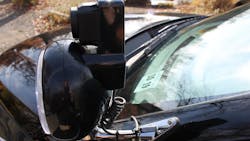AutoLiv, Concealment, Cover & Low-light Survival
As a cadet in any police academy, every future officer and/or deputy learns about a few things that can affect his or her future survival. That’s the very reason they are taught those things: to help them stay alive during their career. Sometimes they are taught how to integrate those concerns and mitigate risks thereby. Other times they’re left to learn how to integrate the concerns via “on the job training” – which translates into, “Oh, crap; I never realized that this plus this equals that, but now that it almost got me shot, I’ll remember from now on.” Let’s take a look at a few of those concerns, something out of Hollywood (which is actually of value at times) and some technology that helps us all the way around.
Concern 1: The large majority of lethal force encounters occur in low or reduced light conditions. Understand that “lethal force encounter” doesn’t always mean “man with a gun.” It could be multiple opponents, someone with an edged weapon or someone with a blunt trauma weapon. The darkness can hide many things. That’s why we learn to use flashlights with proper tactics and we learn to shoot while supporting the use of a flashlight at the same time. Overcoming this challenge of reduced light takes equipment (flashlights) and training; it involves a higher skill level than performing equal functions in normal daylight or a well-lit room.
Concern 2: There is a HUGE difference between cover and concealment. Cover is something you get behind because it will STOP incoming rounds. Concealment is something that hides you but offers you zero protection from incoming rounds. BIG difference. The good news is that it works the same way for the bad guys. Where it matters and we sometimes completely ignore it is this: at night, when we’re searching for a suspect (doesn’t that almost always happen at night?), plain light doesn’t differentiate between cover and concealment. If the suspect is behind a wall, we can’t see him; if he’s behind a big bush, we can’t see him; if he’s laying down in tall grass, we can’t see him. It’s been my experience that suspects hiding at night are more often hidden via concealment rather than cover.
Concern 3: When WE shine a light at night to search we give away our own position as well as information on our direction and pace of travel. Effectively we make ourselves better targets. Unfortunately, without the use of less common technology, we have little choice. We can’t see in the dark. We need to see to be able to identify good guys, bad guys, etc. We have to be able to see to identify what’s a threat and what’s not. So it’s a trade-off: to see everything we need to see we almost HAVE to surrender any advantage we could take in remaining relatively hidden ourselves.
Thankfully, here in the twenty-first century, we have a few technologies that can help us out. This is where Hollywood KIND OF stepped in. Anyone remember the Predator movies? Pick one, any one. The part where the predator could switch what spectrum of light or energy he could see through his visor? THAT was pretty cool and a technology that most officers I know would love to have. Why? Because it would offer us HUGE amounts of data about the suspects and, at the same time, allow us to see things we normally can’t see.
In the non-Hollywood world of reality-on-the-street, we have some technologies that allow us to see things normally beyond our vision capabilities. The challenge has always been making those technologies small enough and agile enough to be used efficiently and without huge inconvenience.
Enter the NOPTIC Spotlight Camera System by AutoLiv. “Seeing” the difference between a suspect’s body heat and the area / items surrounding him, or potentially hiding him, the NOPTIC system gives us one small part of that predator visual capability. That part is the ability to see in THERMAL. Further, by incorporating the system into a tool that we already use in a fairly efficient manner (the spotlight on your cruiser), it enables us to align our eyes with a search “light” source to see things we normally wouldn’t.
Those “things” can present a potential threat from concealment, in low light conditions while we’re NOT behind cover. Yes, it all is inter-related and has a combined impact on our officer survival risk management. The more we can see quick and efficiently during those times when we’re at the greatest risk of a lethal force encounter, the higher we can raise our officer survival expectations. THAT means more of us going home alive at the end of every shift and THAT is worth paying attention to.
